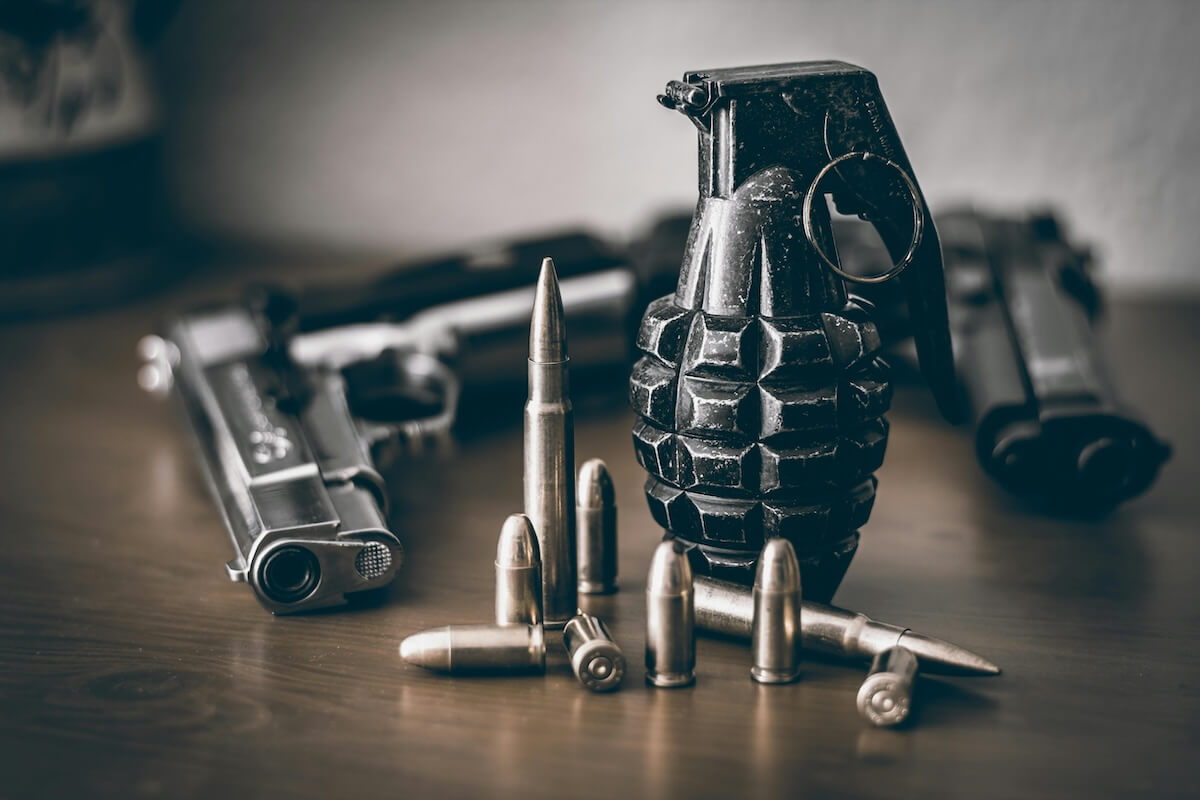I’m still asking myself if A Better Tomorrow II is a glorious film, a total mind fu#*, or a glorious total mind f*&#.
As a sequel, the film continues to explore the original’s themes within “heroic bloodshed” — male bonding, honor, and duty.
But in crafting a sequel, it’s like John Woo’s approach was to take over-the-top but reasonably grounded part one, spray it in the eyes with hot sauce, and demand it dance for the camera.
The movie lacks continuity from time to time. And it gives its plot points about as much weight as its characters (usually) do their gaping gunshot wounds.
Its undercover police operation plot is juxtaposed with off-the-rails scenes with actors tapping into histrionics.
But if John Woo’s vision here seems completely screwed up, maybe it’s because it was completely screwed with.
According to IMDB, Woo’s first cut clocked in at a staggering 160 minutes, pointing toward an epic undercover cop operation saga.
But producer Hark Tsui had other ideas. Tsui demanded the film be made more commercially viable, capping it at 120 minutes so theater owners could fit more daily screenings.
In addition, Tsui felt the film should focus on a different character (Lung) than Woo did (Ken and Kit).
Things got so heated between Woo and Hark that each began editing together their own versions, with cat-and-mouse games like Woo secretly putting missing parts back into the film.
The final cut was created by a third party, Cinema City Editing Unit, who cut the reels of footage as they saw fit.
John Woo has apparently disowned the film, only claiming ownership over the last fight sequence (which, oh, we will get to).
This movie has all the makings of a downright disaster or a so-bad-it’s-shockingly-good watch.
Yet, despite its troubled post-production, it’s neither.
So is A Better Tomorrow 2 a good movie?
What is the Plot of A Better Tomorrow II?
Now a prisoner, Sung Tse-Ho (Ti Lung) is offered parole if he spies on his former boss, counterfeiter Lung Sei (Dean Shek).
Ho declines but changes his mind when he learns that his brother, Kit (Leslie Cheung), is working the police operation.
Though his wife, Jackie (Emily Chu), is pregnant and he is happily married, Kit poses as “Billie” and infiltrates Lung’s circle by dating his daughter, Peggy (Regina Kent).
But when Lung is betrayed and framed for murder by his associate Ko Ying-Pui (Kwan Shan), Ho helps him flee to New York.
Aiding Lung in America is Ken (Chow Yun-fat), the lost twin brother of Ho’s friend and former enforcer, Mark (from the original A Better Tomorrow).
Can Ho, Ken, Kit, and Lung triumph over Ko Ying-Pui and his men?
The Rest of the Main Cast Includes:
- Kenneth Tsang as Ken (The taxi manager from the first film)
- Shing Fui-On as Ko’s partner
- Lam Chung as Ko’s partner
- Ng Man-tat as Mr Wong
- Peter Wang as Sam
- Lung Ming-yan as Chong (Ko’s cold-blooded hitman)
- Louis Roth as Protection Money Collector
- Ken Boyle as New York Counterfeit Buyer
- Lau Siu-ming as Chief Inspector Wu
- Mike Abbott as Assassin
- Cindy Lau as Ken’s restaurant staff
- Steve Mak as Ko’s thug
What’s Working Well Here:
Solid Setup, Straight Beginnings, +2 Points
The film lays out promising dramatic plot threads, spilling internal and external conflict all over the place.
First, Kit begins his investigation into Lung’s counterfeiting operation. Ho, in secret, joins in.
Next, Kit begins dating Lung’s daughter, Peggy. That doesn’t go over well in his marriage to Emily, especially as they have a baby on the way.
And then comes a moral dilemma for Ho. He’s been asked to bring down Lung, his mentor, in exchange for parole. But Lung confides he’s trying to go straight, though nobody believes he wants to. It puts Ho in a tough position, as helping Kit to bring down Lung weighs on his conscience.
A Ken for All Seasons, + 4 Points
Like a hokey mystery novel, the film resurrects its badass poster boy of the franchise: Mark, shot down in the first installment, is now Ken, his identical twin brother (Chow Yun-fat reprising the role).
Ken is as badass as Mark but with a dash of looniness. He has his brother’s swagger but is the Curly to Mark’s Moe (The Three Stooges).
Ken even wears his dead brother’s coat into the final battle, comically hanging grenades from the old bullet holes.
I’ll admit, Ken is off-putting at first, but by the end shootout (which, again, we’ll get to) is your favorite.
What’s extra strange is that, with the freedom to name him anything, they went with Ken.
There’s already a Ken in the film’s small group of heroes: the taxi cab owner from the first film, who returns for the sequel. It’s been suggested online that they get around this by having nobody say that Ken’s name.
Go figure.
Men in Soap Opera, +2 Points
The film gets so soaptastic it’s like one big lathered hot tub of man bodies.
Like the violence, the broody, sweeping bromance of the first film is thrust even higher in this sequel.
There are plenty more men-on-platonic-men stares and moments of true love between brothers.
But here, men rely on men to bring them back from the depths.
The epitome of this is Ken trying to nurse a catatonic Lung back to health. After Lung goes certifiably crazy (more on that later), he loses the will to eat. So Ken attempts to pour milk into Lung’s mouth, dabbing his throat as it dribbles down his cheeks.
Action Scenes, +8 Points
This sequel goes bigger and bloodier, featuring 13 action sequences compared to the original’s 5.
Among other scenes, the film features the incredible hotel shootout, which inspired at least three levels of the Max Payne franchise.
In one of the most kickass gunfights you can find, Ken walks around shotgunning mafiosos who come at him as determined as that paperboy in Better Off Dead who wants his two dollars but, you know, playing for blood.
You’d think maybe they’d give up after Ken has killed so many of them, but the mob goons just really want their restaurant protection money.
The highlight has to be Ken’s crazy slide down a staircase on his back, firing up at a thug from below. It’s a launching pad moment for Woo, recreated in his future films.
And then there’s the final shootout, an orgy of violence that is John Woo insanity at its most breathless and that you’ll want to revisit again and again.
The body count reaches close to a hundred in ~12 minutes of glory as three of our group – Ho, Ken, and Lung – storm the castle, so to speak.
It’s a crazy payoff of astounding, stylish violence.
There are blood-stained hallways littered with bodies as Ko’s goons have this silly habit of walking into Lung and Ho’s machine gun fire.
Things get frantic as Lung and Ho head upstairs in search of Ko, taking bullets. And when the fray moves hand-to-hand, former martial arts star Ti Lung, as Ho, even pulls out a samurai sword and starts chopping toughies down.
But Ken is the style guy, and he’s not outdone in this climax.
Tossing grenades and seeming to forget how to run away from the blast, Ken delicately walks about the building in his dead brother’s coat and glasses, dual-wielding pistols with precision and dealing handfuls of bullets into every bad guy’s torso. It’s “gun-fu” at its thrilling, sleeky finest.
Lastly, there’s the excellent gunfighters’ duel between Ken and Ko’s Le Samourai-like Assassin, each man with a pistol underfoot to see who can dive and draw first.
Due to copyright issues, I couldn’t put in a YouTube clip of these action scenes. But if you want to search for it on YouTube yourself, I bet people have posted it there.
What’s Not Working so Well Here:
Exposition, -1 Point
Even hokier than Ken’s resurrection is how we find out about him.
Ho visits a painter who seems to be the group’s fan club. Without explanation, this artist, whom we’ll call Mr. Exposition, seemingly spends all his time painting Mark, Kit, and Ho.
When Ho picks up a picture of two young twins, Mr. Exposition randomly tells Ho, oh, you didn’t know that kid in the picture with your absolute longtime best friend, Mark, is his twin? For some reason, I have a picture of them when they were kids and Mark’s old belongings that I’ve been collecting.
All writers have to jam something into the story through contrived means from time to time. Still, there had to be a better solution than Mr. Exposition.
Bizarre Scenes, -4 Points
Choose your own review for this bit.
If you want this film to be literal and awesome, this is a negative. If “good” to you is liking things spicy and bizarre, count this in the positive points.
In the second act, when Lung flees to New York, so does the film’s sanity. What’s been a mostly straight police/gangster drama has a sideshow up its sleeve, and strange ideas pop their way into the film.
With many catastrophes befalling him everywhere all at once, old Mr. Lung enters the looney bin – for real. He’s off it to the point that mental institution workers are bizarrely force-feeding him bowls of soup while he resists, the liquid dribbling down the sides of his cheeks. And he’s tied down and pumped full of tranquilizers until he’s rescued by Ken.
Though Ken is not qualified to tackle insanity, true to the film’s spirit, he will use male bonding to help Lung through his mental issues.
But even with all the mannish charms, Ken struggles to feed the catatonic Lung. It gets so bad that Ken, in frustration, dumps his entire fridge contents onto the floor.
Yet Ken’s fridge-spilling tantrum entices Lung to bite into a piece of raw beef, which presumably didn’t taste good. So then, like an ape catching the concept of fire for the first time, Lung dramatically unwraps and shares an orange with Ken.
While he may be destined for a bad night of food poisoning or even hospitalization from gnawing at raw cuts of meat, still-crazy Lung at least dines again, thanks to Ken’s male-on-male, platonic attention.
Still, this doesn’t end Lung’s psychotic state. During the whole hotel shootout, Uncle Lung is cowering and moaning like Gollum high on amphetamines.
Then there’s the ludicrous antics of Ken’s beef with the New York mafia.
In the infamous fried rice scene, Ken, a restaurant owner, refuses to pay protection money.
But the scene turns into a strange face-off (get it?) between Ken and boilerplate mafiosos that lasts and lasts and lasts and cycles Ken from everything through anger to absolute despair.
As Ken demands the gangster “apologize to the rice,” it’s madness or magic, depending on your preference, but absolutely something from nowhere.
Due to copyrights, I couldn’t post a link to YouTube clips of the fried rice scene. But if you search for it, I bet you can find someone who has posted it.
Should I Watch A Better Tomorrow II?
Total Arbitrary Points Score: 11 Points
A Better Tomorrow II is a clash of a director’s and producer’s visions.
Had the film contained Woo’s original footage and desired runtime, I could see it turning into the epic cop/gangster drama of a master, peppered with thrilling action and just occasional bits of silly.
As cut, it’s a coherent movie bookending a middle act that flies wildly off course.
The film segues into highly determined mob characters hell-bent on the suffering of a dissenting restaurant. Like a daytime soap, it pulls a secret twin move to resurrect a character. It casts another into a mental institution, including a bizarre sequence of teaching him to relearn to eat.
Still, the film features plenty of what you came for: loads of action, including a stylish and bonkers end shootout that may win a record for the biggest pile of dead extras in a small space.
I have so many questions one rip-roaring ending can’t answer, but what can you do with this film but gawk at it.
By the film’s end, I felt as tired and shot up as its surviving characters. Yet I’m glad I took this occasionally bizarre wild ride.
So if you plunked down to watch the first installment, you might as well see where this crazy train goes.
Enjoyed this Post?
Thank you so much. If you’d like to get a ping when I have a new article, you can join my newsletter below.
Disclaimer:
This review’s factual information was gathered through online sources, like Wikipedia, IMDB, or interviews. Misrepresentations and errors are possible but unintentional.
Making art is hard. This is a fan’s blog. Any criticisms are meant to be constructive.




